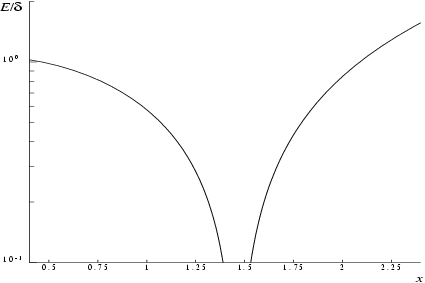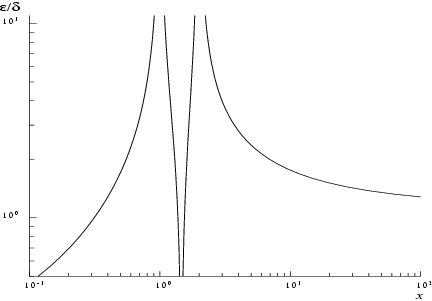NAG Library Routine Document
S14ABF
1 Purpose
S14ABF returns the value of the logarithm of the gamma function, , via the function name.
2 Specification
| REAL (KIND=nag_wp) S14ABF |
| INTEGER |
IFAIL |
| REAL (KIND=nag_wp) |
X |
|
3 Description
S14ABF calculates an approximate value for . It is based on rational Chebyshev expansions.
Denote by
a ratio of polynomials of degree
in the numerator and
in the denominator. Then:
- for ,
- for ,
- for ,
- for ,
- and for ,
For each expansion, the specific values of
and
are selected to be minimal such that the maximum relative error in the expansion is of the order
, where
is the maximum number of decimal digits that can be accurately represented for the particular implementation (see
X02BEF).
Let
denote
machine precision and let
denote the largest positive model number (see
X02ALF). For
the value
is not defined; S14ABF returns zero and exits with
. It also exits with
when
, and in this case the value
is returned. For
in the interval
, the function
to machine accuracy.
Now denote by
the largest allowable argument for
on the machine. For
the
term in Equation
(1) is negligible. For
there is a danger of setting overflow, and so S14ABF exits with
and returns
. The value of
is given in the
Users' Note for your implementation.
4 References
Abramowitz M and Stegun I A (1972) Handbook of Mathematical Functions (3rd Edition) Dover Publications
Cody W J and Hillstrom K E (1967) Chebyshev approximations for the natural logarithm of the gamma function Math.Comp. 21 198–203
5 Parameters
- 1: X – REAL (KIND=nag_wp)Input
On entry: the argument of the function.
Constraint:
.
- 2: IFAIL – INTEGERInput/Output
-
On entry:
IFAIL must be set to
,
. If you are unfamiliar with this parameter you should refer to
Section 3.3 in the Essential Introduction for details.
For environments where it might be inappropriate to halt program execution when an error is detected, the value
is recommended. If the output of error messages is undesirable, then the value
is recommended. Otherwise, if you are not familiar with this parameter, the recommended value is
.
When the value is used it is essential to test the value of IFAIL on exit.
On exit:
unless the routine detects an error or a warning has been flagged (see
Section 6).
6 Error Indicators and Warnings
If on entry
or
, explanatory error messages are output on the current error message unit (as defined by
X04AAF).
Errors or warnings detected by the routine:
On entry,
. If
the function is undefined; on soft failure, the function value returned is zero. If
and soft failure is selected, the function value returned is the largest machine number (see
X02ALF).
On entry,
(see
Section 3). On soft failure, the function value returned is the largest machine number (see
X02ALF).
7 Accuracy
Let and be the relative errors in the argument and result respectively, and be the absolute error in the result.
If
is somewhat larger than
machine precision, then
where
is the digamma function
.
Figure 1 and
Figure 2 show the behaviour of these error amplification factors.
These show that relative error can be controlled, since except near relative error is attenuated by the function or at least is not greatly amplified.
For large , and for small , .
The function has zeros at and and hence relative accuracy is not maintainable near those points. However absolute accuracy can still be provided near those zeros as is shown above.
If however, is of the order of machine precision, then rounding errors in the routine's internal arithmetic may result in errors which are slightly larger than those predicted by the equalities. It should be noted that even in areas where strong attenuation of errors is predicted the relative precision is bounded by the effective machine precision.
None.
9 Example
This example reads values of the argument from a file, evaluates the function at each value of and prints the results.
9.1 Program Text
Program Text (s14abfe.f90)
9.2 Program Data
Program Data (s14abfe.d)
9.3 Program Results
Program Results (s14abfe.r)


